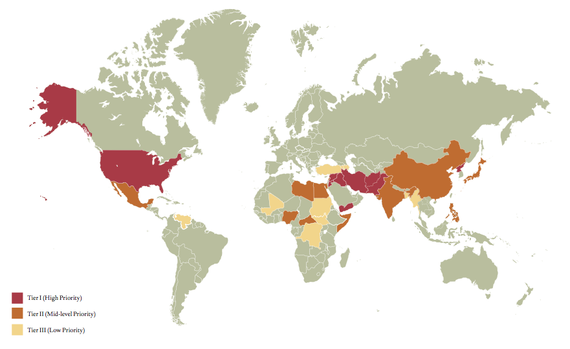 |
| The Global Conflicts to Watch in 2014 - The Atlantic |
U.S. thresholds for high-order conventional and
nuclear war are diffuse and dynamic, differ across regions, and are hard
to enforce. Since 9/11, three of the primary nation-state competitors
to the United States — Russia, China, and Iran — have successfully
exploited or stretched U.S. thresholds for high-order war in order to
further their strategic ends and, in the process, undermine U.S.
interests. Each of these countries has made expert use of some
combination of measures short of war, including economic leverage,
terrorism, limited military incursions, aggressive diplomacy, and covert
action, to enact its strategies. Some argue that these actions
constitute a new international order, or perhaps a new way of war. They
do not: Use of measures short of war is time-tested nation-state
behavior. U.S. policymakers and military service leaders would benefit
from additional consideration of these measures, how they are used
against the United States, and how they might be defended against and
exploited to further U.S. strategic interests.
Key Findings
Use of Measures Short of War Is Not a New Phenomenon
- Nothing can be done to eliminate the threat that measures short of war pose.
- Instead, addressing their use requires development and maintenance of an effective U.S. grand strategy that seamlessly incorporates measures short of war into a long-term, globally integrated plan.
Recommendations
- If the United States is to preclude further erosion of its global influence by nation-state competitors, it will have to address the problems of threshold exploitation and stretching. Policymakers and the military services should consider ways to better identify, forestall, and counteract the use of measures short of war against U.S. and allied interests.
- It must recognize that neither linear threshold paradigms nor revolutionary terms can fully explain such events as Russia's involvement in Crimea or Iran's relationship with Iraq.
Related/Background:
- China’s military operations other than war: the military legacy of Hu Jintao - SIPRI-Hu Kamphausen.pdf
This paper looks at China’s military operations other than war ( MOOTW; in Chinese, 非战 争军事动 ). It addresses the ways in which MOOTW supports China’s foreign policy goals; analyses the progress made by China’s military, the Peoples Liberation Army (PLA) , in a number of MOOTW missions; and assesses the linkage between Hu Jintao’s December 2004 speech in which he called for the PLA to carry out its ‘new historic missions’ . The paper finds that MOOTW is an important element of Chinese foreign policy in the H u Jintao era, and PLA efforts to become a more ‘internationalized force’, including conducting MOOTW missions abroad (peacekeeping, anti - piracy and others), can be directly linked to Hu Jintao’s articulation of ‘new historic missions’ . The paper further finds that in many ways, the PLA has taken the easy steps with regard to MOOTW. More challenging are the decisions PLA leaders must make about the next steps — whether the PLA will participate in UN peace enforcement missions or in other international missions like the anti - piracy patrols in the Gulf of Aden, and whether the PLA can become a reliable regional disaster relief force provider, among others. - James
R. Ayers, Major, USAF; "MILITARY OPERATIONS OTHER THAN WAR IN THE NEW
WORLD ORDER: AN ANALYSIS OF JOINT DOCTRINE FOR THE COMING ERA," Graduate
Research Paper AFIT/GMO/LAL/96J-1
The United States has experienced numerous eras of distinct international systems which governed its relationship with other nations. The end of the Cold War symbolized a transition point between such systems. Historically, the nature of a new order as well as the transitional point between orders is fraught with uncertainty. Nonetheless, instruments of national power such as the military must respond to the changing system to remain effective. The post-Cold War era has been characterized by an increased use of the military for operations short of war to include humanitarian operations, peacekeeping, sanction enforcement, etc. Although these missions are not new to the Armed Forces, military doctrine has only begun to address the unique challenges involved in executing operations short of war. Joint Publication 3-07, Joint Doctrine for Military Operations Other Than War (MOOTW), lists six fundamental principles for MOOTW. This research applies the concepts embodied in the principles of MOOTW with three MOOTW models; the Range of Military Operations Model developed by the U.S. Army, the Crises and Lesser Conflicts Model developed by Rand researchers Carl H. Builder and Theodore W. Karasik, and the MOOTW Characteristics Model developed by RAND researchers Jennifer M. Taw and John E. Peters. - JP 3-07 Joint Doctrine For Military Operations Other Than War - jp3_07.pdf
- Short of General War: Perspectives on the Use of Military Power in the 21st Century - pub983.pdf
- Clausewitz in Wonderland | Hoover Institution
- x
No comments:
Post a Comment